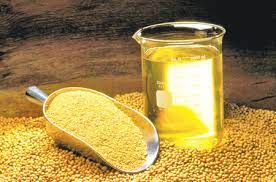
Image Source
The improved mutant line SBM-22 was selected from 300 gray level by applying gamma rays (150, 200, 250, 300 and 350 gray) to the seeds of Barisyabin-5 variety by following the single plant selection method in the next generation. Later in 2019, the line was registered by the National Seed Board as Binasyabin-6 for cultivation in soybean cultivated areas of the country.
Identification feature
The tree is medium in height, the leaves are dark green compared to other varieties and the seed color is light yellow and brighter than the seeds of other varieties. The variety is tolerant to viral yellow mosaic disease and less insect infestation. Moreover, the variety is tolerant to moderate salinity.
Other features
Tree height 55-63 cm; Number of primary branches 2-4; The number of fruits per tree is 48-60; The number of seeds per fruit is 2-3; 100 seeds weigh 11.0-13.5 grams; Lifespan 105-115 days; Average yield 2.80 tons / ha .; Maximum yield 3.20 tons / ha.
Land selection
Soybean can be cultivated in both Rabi and Kharif seasons in the soil and climate of this country. Sandy loam to loamy loam soils are more suitable for soybean cultivation. The land selected for cultivation in Kharif or monsoon season must be elevated and waterable. It can be cultivated in medium to low lands during Rabi season. Noakhali, Laxmipur, Chandpur, Bhola, Jessore, Rangpur and Mymensingh regions are suitable for cultivation.
Land ready
Depending on the type of soil, seeds should be sown by loosening the soil with 3-4 cultivations and ladders. After leveling the land with a ladder, if the plot is made in a convenient size, then it is convenient to apply irrigation, drainage and interim care.
Sowing time
In Bangladesh, soybean can be cultivated in both Rabi and Kharif-2 seasons. The best time for sowing is in Rabi season from the beginning of Poush to mid-Magh (mid-December to end of January) and in Kharif-2 season from mid-Ashar to mid-Bhadra (first of July to last of August).
Seed rate
Seed sowing requires 55 kg per hectare (22 kg per acre) and row sowing requires 60 kg (28 kg per acre).
Sowing method
Soybean seeds are best sown in rows, but can also be sown by scattering. If sown in rows, the distance from row to row is 30 cm in Rabi season. Or 12 inches. Seeds should be sown 1.0 - 2.0 inches deep in rows. If it is sown in Rabi season, after sowing the seeds should be sprinkled and covered well with a ladder. If the soil is muddy in Kharif-2 season, the seeds will germinate if given at a small depth.
Dosage and application of fertilizers
Fertilizer levels vary in the agricultural environment of Bangladesh. (Generally approved fertilizer levels for soybean cultivation are mentioned in the table). Before the last cultivation, the soil should be leveled by spraying all the chemical fertilizers. Applying rotten dung or compost manure with chemical fertilizers will reduce the need for chemical fertilizers. Chemical fertilizers should be sprayed on the land before the last cultivation and then the soil should be leveled with a ladder.
Application of germs
Soybean plants can collect nitrogen from the air with the help of Rhizobium bacteria and store it in tree roots. Nodules or cocoons are easily formed in the roots of the plant if the seeds are mixed with germs before sowing. The plant gets nitrogen from the cocoon formed from the roots. Note that urea fertilizer is not usually required for application of germs.
Methods of use of germs
Take one kg of seeds in a container and soak the soybean seeds in clean water with wet hands so that the surface of all the seeds gets wet. After mixing 20-30 gms of chitagur or cold rice starch in one kg of soybean seeds, 20-30 gms of germs should be mixed and stirred well so that the germs mixed with the chitagur mixed sticks evenly. The seeds should be sown as soon as possible after mixing the germs, because if the seeds are left for a long time after mixing the germs powder, the quality of the germs is lost.
Interaction
Weeds should be cleared within 15-20 days of seedling emergence. If the tree is very dense, it should be thinned and the distance from tree to tree in the row should be 2.0-3.0 inches. When the seedlings are 30-35 days old, they should be chopped with a hoe or spade to control weeds or if the tree is very dense, it should be thinned Supplementary irrigation may be required during flowering and harvesting of fruits or pods during Rabi season. If there is no rain, first irrigation should be given 20 to 30 days after seed germination and second irrigation 50-55 days after seed germination. In the kharif season, no irrigation is required for this crop, but drainage should be made when water accumulates in the land.
Authors get paid when people like you upvote their post.
If you enjoyed what you read here, create your account today and start earning FREE BLURT!
If you enjoyed what you read here, create your account today and start earning FREE BLURT!
Sir before i have delegate 1200 power,now my delegation is total 6000 blurt power to @looking
Thanks